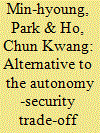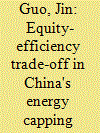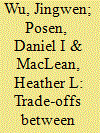|
|
|
Sort Order |
|
|
|
Items / Page
|
|
|
|
|
|
|
| Srl | Item |
| 1 |
ID:
137226


|
|
|
|
|
| Summary/Abstract |
Most of the alliances that were formed during the Cold War period were known as a so-called “asymmetric alliance,” which means strong states provide one-sided support for the partner in a relationship at the expense of the weaker power’s autonomy. In an asymmetric alliance, a weak state gets full security support from the superpower, but in return, the weak state loses its autonomy. In this case, there is a trade-off between security and autonomy of the weaker state. This is what the Autonomy-Security Trade-off Model suggests. However, after the end of the Cold War, the weak powers, especially the developing country, have tried to increase its autonomy without any loss of its security—unlike what the Autonomy-Security Trade-Off Model argues. In this case, there may not be necessarily a trade-off between autonomy and security if a weak state decides to increase both autonomy and security simultaneously. The weak state does not usually want to lose its security, therefore it tries to find a strategy that can increase its autonomy without decreasing its security. In this sense, this paper argues that the Autonomy-Security Trade-off model has limitations to explain the above kind of national action after the Cold War. In line with this, the goal of this paper is to offer an alternative model to explain an asymmetric alliance relationship by looking at the case of the
ROK-U.S. alliance at the turn of the twenty-first century.
|
|
|
|
|
|
|
|
|
|
|
|
|
|
|
|
| 2 |
ID:
163538


|
|
|
|
|
| Summary/Abstract |
As a part of the transition to a sustainable economy, China has set a cap on primary energy consumption for the first time, of 5.0 billion tonnes of standard coal equivalent by 2020. However, there is a debate on the cap feasibility and failure to adequately address the underlying equity-efficiency trade-off, which hampers achievement. This paper identifies some key challenges ahead, including the coal-dominant energy mix, declining financial support, inconsistent central-local goals, rising costs of energy-saving measures and quality of energy statistical data. By quantifying the preference of each providence toward equity-based or efficiency-based allocation schemes, the great disparity among provinces is revealed and the equity-efficiency trade-off relationship is confirmed. Developing regions, primarily located in central and western areas, tend to favor equity-based disaggregating schemes. Contrarily, developed coastal provinces strongly favor efficiency-based schemes. The present national disaggregation schemes are mainly based on historical energy consumption, but disregard the provincial development gap and efficiency factors. We conclude that this ambitious goal is likely within reach, but increased efforts and flexible instruments are needed.
|
|
|
|
|
|
|
|
|
|
|
|
|
|
|
|
| 3 |
ID:
179666


|
|
|
|
|
| Summary/Abstract |
Technological progress is an effective way to improve fuel economy in vehicles. Using a rich model-level dataset of all new passenger cars in China from 2010 to 2019, this paper estimates progress in fuel economy after controlling for increases in vehicle performance. Considering the unique structure of the automobile industry in China, we explore differences between indigenous vehicles (IV), joint venture vehicles (JV), and foreign vehicles (FV). The results show that a 10% increase in curb weight is correlated with a 6.4% increase in fuel consumption. When holding other vehicle characteristics constant, technological progress can reduce fuel consumption by 3.5% annually. Technological progress is larger for JV (3.9%) than FV (3.3%) and IV (3.1%). In particular, IV produced by firms that are also engaged in JV showed slower technological progress (2.6%) than other IV counterparts (3.9%). A majority of JV would be able to meet future fuel consumption standards on individual vehicles at the average historical rate of technological progress. In contrast, IV will face a greater challenge, especially for IV produced by firms with JV. Although weight reduction can reduce fuel consumption, it plays a limited role in regulatory compliance due to the weight-based regulations.
|
|
|
|
|
|
|
|
|
|
|
|
|
|
|
|
|
|
|
|
|